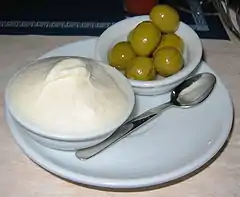Aioli
Aioli, allioli or aïoli (/aɪˈoʊli/ or /eɪˈoʊli/; Provençal Occitan: alhòli [aˈʎɔli] or aiòli [aˈjɔli]; Catalan: allioli [ˌaʎiˈɔli]; Spanish: alioli [ˌaliˈoli]) is a sauce made of garlic, salt, and olive oil and found in the cuisines of the northwest Mediterranean, from Valencia to Calabria.
 Aïoli | |
| Type | sauce |
|---|---|
| Place of origin | eastern Spain and southern France |
| Main ingredients | Olive oil, garlic |

The names mean "garlic and oil" in Catalan/Valencian and Provençal. It is found in the cuisines of the Mediterranean coasts of Spain (the Valencian Community, Catalonia, the Balearic Islands, Murcia and eastern Andalusia), France (Provence) and Italy (Sicily and Calabria).
Some versions of the sauce are closer to a garlic mayonnaise, incorporating egg yolks and lemon juice, whereas other versions are without egg yolk and have more garlic. This gives the sauce a pastier texture, while making it more laborious to make as the emulsion is harder to stabilize.[1][2][3][4] There are many variations, such as adding lemon juice or other seasonings. In France it may include mustard.[5][6] It is served at room temperature.
Like mayonnaise, aioli is an emulsion or suspension of small globules of oil and oil-soluble compounds in water and water-soluble compounds. In Spain, purists believe that the absence of egg distinguishes aioli from mayonnaise, but that is not the case in France and other countries, where cooks may use egg or egg yolk as an emulsifier. Using only garlic as an emulsifier requires that the cook thoroughly crush it and add oil drop by drop so excess oil does not "cut" the aioli.
Since about 1990, it has become common in the United States to call all flavored mayonnaises aioli.[7] Purists insist that flavored mayonnaise can contain garlic, but true aioli contains garlic and no other seasoning.[8]
Etymology
The word is a compound of the words meaning "garlic" and "oil".
The English spelling comes from the French aïoli, which itself comes from Occitan. The spelling in Occitan may be alhòli, following the classical norm, or aiòli, following the Mistralian norm.[9] In Catalan (Catalan diverged from Old Occitan between the 11th and 14th centuries [10]), it is spelled allioli (pronounced [ˌaʎiˈɔɫi]). The most common term in Spanish is alioli, an adaptation from Catalan, although it is also called ajoaceite, ajiaceite, ajolio or ajaceite.[11] It is also spelt alioli in Galician.
Basic recipe
Garlic is crushed in a mortar and pestle and emulsified with salt, and olive oil. Today, aioli is often made in a food processor or blender, but some traditionalists object that this does not give the same result.[4]
Serving
In Malta, arjoli or ajjoli is commonly made with the addition of either crushed galletti or tomato.
In Occitan cuisine, aioli is typically served with seafood, fish soup, and croutons. An example is a dish called merluça amb alhòli.
In the Occitan Valleys of Italy it is served with potatoes[12] boiled with salt and bay laurel.
In Provençal cuisine, aioli or, more formally, le grand aïoli, aioli garni, or aïoli monstre is a dish consisting of various boiled vegetables (usually carrots, potatoes, artichokes, and green beans), poached fish (normally soaked salt cod), snails, canned tuna, other seafood, and boiled eggs, all served with aioli. This dish is often served during the festivities on the feast days of the patron saint of Provençal villages and towns. It is traditional to serve it with snails for Christmas Eve and with cod on Ash Wednesday.[4] Aïoli is so strongly associated with Provence that when the poet Frédéric Mistral started a regionalist Provençal-language newspaper in 1891, he called it L'Aiòli.[2][13]
The Provençal cuisine fish soup bourride is generally served with aioli.[14]
In Spain, particularly in Catalan cuisine, allioli is often served with arròs negre, arròs a banda, fideuà, with grilled snails (cargols a la llauna), lamb, rabbit, vegetables, boiled codfish (bacallà a la catalana, bacallà amb patates) and comes in other varieties such as allioli de codony (allioli with boiled quince, not the preserve) or allioli with boiled pear.[5] Other commonly used vegetables are beets, fennel, celery, zucchini, cauliflower, chick peas, and raw tomato.[4][6]
See also
- Agliata – A savory and pungent garlic sauce and condiment in Italian cuisine
- Dipping sauce
- Garlic sauce
- List of garlic dishes – Wikipedia list article
- Mujdei – A spicy Romanian sauce made mostly from garlic and vegetable oil
- Skordalia – A thick purée in Greek cuisine using crushed garlic with a bulky base and olive oil
- Toum – A garlic sauce common in the Levant
References
- J.-B. Reboul, La Cuisinière Provençale 1910 (1st edition); 1989 (25th edition), p. 88
- Robert Courtine, The Hundred Glories of French Cooking (tr. Derek Coldman), 1973, p. 140
- Henri Philippon, Cuisine de Provence, 1977 (2nd ed), p. 20
- Mireille Johnston, The Cuisine of the Sun, 1976; Johnston gives one recipe without extra flavorings (p. 75) and one with mustard (p. 229)
- Prosper Montagné, Larousse Gastronomique (1938, tr. 1961), s.v.
- Olney, Richard (1994). Lulu's Provençal table : the exuberant food and wine from Domaine Tempier Vineyard. New York: HarperCollins. pp. 124–5. ISBN 0-06-016922-2.
- Google ngrams
- David Tanis, A Platter of Figs and Other Recipes, ISBN 1579653464, 2008, p. 102
- cf. Occitan writing systems
- Riquer 1964.
- Real Academia Española and Asociación de Academias de la Lengua Española (2005). "ajiaceite", Diccionario panhispánico de dudas. Retrieved on 16 July 2019.
- "La cucina occitana (area cuneese)" (in Italian). Archived from the original on July 23, 2011. Retrieved 2009-04-11.
- Julian Wright, The Regionalist Movement in France 1890-1914: Jean Charles-Brun and French Political Thought, ISBN 0199264880, p. 47-48 and passim
- Waverly Root, The Food of France, 1958-1992, ISBN 0679738975, p. 359
External links
 Media related to Aioli at Wikimedia Commons
Media related to Aioli at Wikimedia Commons